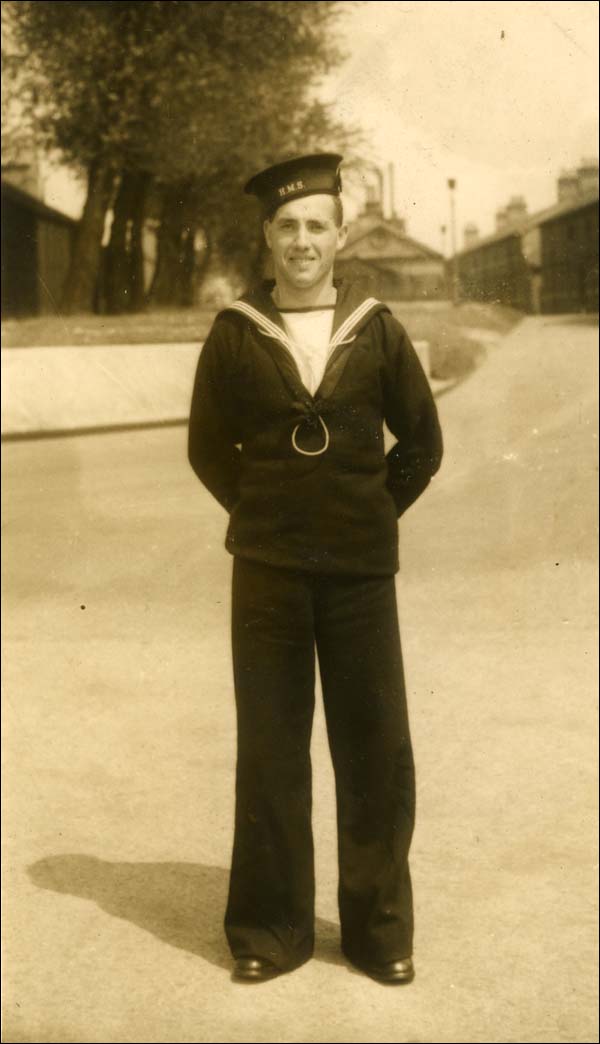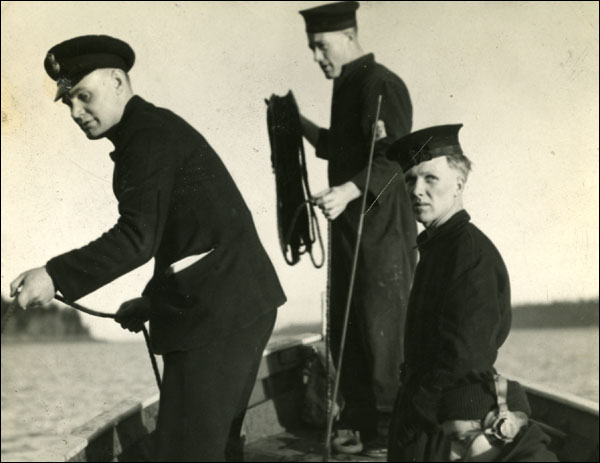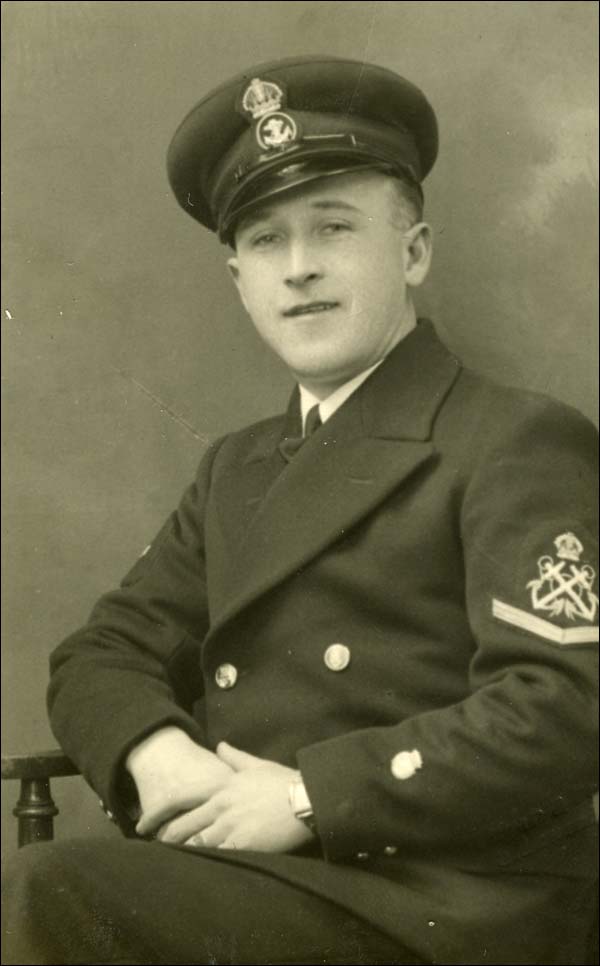Royal Navy
In keeping with its seafaring traditions, Newfoundland and Labrador produced more volunteers for the Royal Navy (RN) than for any other single branch of the Armed Forces during the Second World War. Unlike their counterparts in the Royal Artillery, who were grouped together in two Newfoundland regiments, these recruits were scattered throughout the navy and served all over the globe in various capacities – they escorted convoys in the Battle of the Atlantic; assisted in the assault landings at Normandy and Madagascar; helped rescue Allied troops from the beaches of Dunkirk and Greece; and provided a shuttle service for troops along the North African coast.

Recruiting Begins
When hostilities broke out, Newfoundland and Labrador lacked any kind of naval defence force. The country's branch of the Royal Naval Reserve, established in 1902 to train local fishermen and seamen for service with the RN, had disbanded by 1921 for economic reasons. Nonetheless, the RN was the first military organization to enlist volunteers from Newfoundland and Labrador. On September 14, 1939, it asked the Commission of Government to recruit 625 experienced fishermen or seamen for special service in the Northern Patrol, which guarded Atlantic shipping lanes. Winston Churchill, then First Lord of the Admiralty, took a special interest in the endeavor, calling Newfoundlanders “the hardiest and most skilful boatmen in rough seas who exist.”
Newfoundland Governor Sir Humphrey Walwyn issued a public proclamation on October 24, requesting volunteers to serve for the duration of the war. Recruiters accepted men between the ages of 18 and 35, who stood at least five feet, two inches tall, and weighed no less than 112 pounds. They also required volunteers to have perfect eyesight and be able to read and write. While recruiters gave preference to single applicants, they also considered married men.

The response was enthusiastic. Although volunteers came from all over the island, interest was particularly strong in the outports, where most men had been handling boats since childhood. The possibility of earning a steady naval wage of two shillings a day was also attractive to many people in Newfoundland and Labrador, who were still recovering from a period of economic hardship following the First World War and Great Depression. The first draft of 198 recruits left St. John's for Liverpool on November 27 aboard the SS Newfoundland; by the end of January, all 625 special servicemen had been recruited.
Service Overseas
Once in England, most of these recruits served on minesweeping trawlers or armed merchant cruisers. The latter were an assortment of vessels – typically passenger liners – which the British Admiralty had requisitioned at the outbreak of war and outfitted with weaponry and armour. Their mission was to intercept neutral vessels bringing goods to enemy ports, capture enemy merchant ships, and defend Allied convoys from enemy warships and submarines. Cruisers usually spent 18 or 19 days at sea, followed by about a week in an Allied harbour to restock and refuel. While on duty, seamen with the Northern Patrol spent much of their time keeping watch for enemy vessels. This was punctuated by daily gun drills and various chores.
The Northern Patrol was effective in the early stages of the war, and by April 1940, had intercepted some 400 ships. However, German U-boats and warships quickly took a heavy toll on the merchant cruisers, which possessed only inferior armaments. By the end of 1940, 10 cruisers had been sunk – six of which carried Newfoundlanders. One such vessel, the Scotstoun, was carrying 23 Newfoundlanders among its crew when it went down near Ireland after a German torpedo struck it on June 13, 1940. Six men died in the sinking, including Ordinary Seaman H.G. Squires from Old Perlican, Trinity Bay. The survivors spent eight hours in lifeboats before being rescued.
In the following years, the Admiralty relieved the armed merchant cruisers of escort duty and assigned them various tasks of reduced responsibility – these included transporting troops and guarding the Denmark Strait.
More Volunteers Requested
Immediately after it recruited the 625 special servicemen in January 1940, the Commission of Government launched a second campaign, at the RN's request, to enlist an additional 1,000 volunteers for general naval service. Requirements regarding education, age, height, and weight were the same as for the special servicemen, but volunteers were no longer required to possess seafaring experience if they were in good physical shape. As a result, enlistment was not only open to fishermen and seamen, but to miners, loggers, and men in a variety of professions. An abundance of volunteers once again applied, but about 40 per cent were rejected on medical grounds. Nonetheless, recruiters quickly met their quotas and by the end of July all 1,000 enlistees had arrived in England.
By December 6, 1940, the Admiralty had requested two more 1,000-men drafts. However, the Royal Artillery and Royal Air Force had also begun recruiting in Newfoundland and Labrador at this point, leaving fewer men available for naval service. Of the 2,000 requested volunteers, only 1264 were sent overseas. An additional 343 enlisted in the United Kingdom, many of whom were serving with the merchant navy or Newfoundland Overseas Forestry Unit.
Active Service
General servicemen from Newfoundland and Labrador were dispersed throughout the RN and assigned a wide range of naval tasks. Some served on minelayers in enemy waters, others swept for mines in friendly waters on board trawlers. Still more manned the landing ships that brought Allied invasion troops to Normandy, Sicily, North Africa, and other places, or on motor torpedo-boats that attacked the German-occupied coasts of France and Norway.

However, most sailors from Newfoundland and Labrador served in the Battle of the Atlantic, aboard the numerous escort vessels that helped Allied convoys deliver supplies to Britain and other European countries. The work was both dangerous and difficult as sailors had to deal not only with the Atlantic's unpredictable and often hazardous weather conditions, but also with a constant threat of U-boat attack. On December 19, 1941, for example, 16 Newfoundlanders were killed when a U-boat torpedoed their destroyer, HMS Stanley, while it was accompanying a convoy to Britain. The men died off the coast of Cape de Roca, near Lisbon.
War's End
After the European war ended in May 1945, the RN continued to draft recruits for service in the Pacific. Many sailors from Newfoundland and Labrador objected, arguing that although they had signed on for the duration of hostilities, they had assumed that meant the war against Germany, not against Japan. Nonetheless, the RN continued to send seamen to the Far East until hostilities ended in August, and it was not until the end of 1945 that the majority of recruits returned to Newfoundland and Labrador.
Casualties were high throughout the war, and some 350 of the country's sailors died before hostilities ended. Despite the hardships and fatalities, seamen from Newfoundland and Labrador distinguished themselves as resourceful and hard-working recruits, who were particularly skilled in the handling of small boats. During the summer of 1940, RN Vice-Admiral R.H.T. Raikes stated that "commanding officers were particularly unanimous in their praise of the keenness and smartness displayed by the Newfoundland men."




